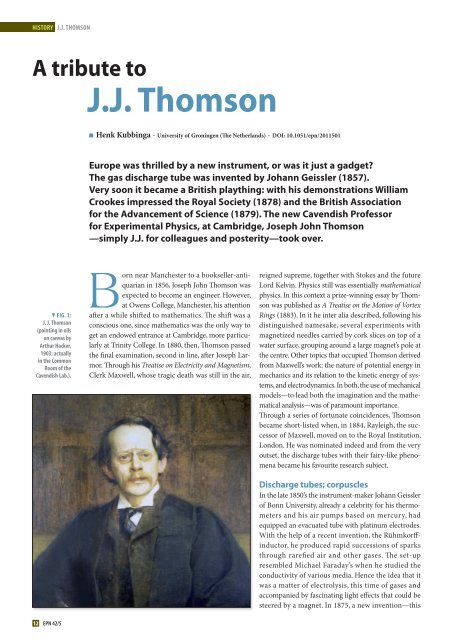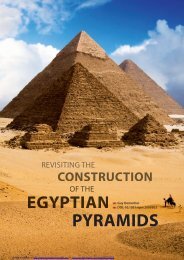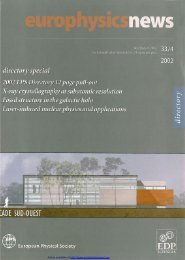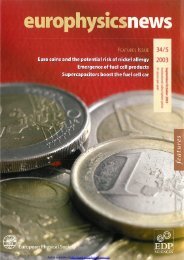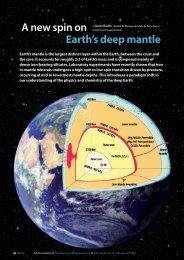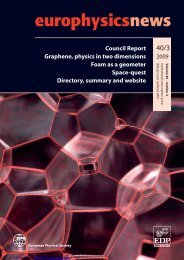PDF (11.37 MB) - Europhysics News
PDF (11.37 MB) - Europhysics News
PDF (11.37 MB) - Europhysics News
Create successful ePaper yourself
Turn your PDF publications into a flip-book with our unique Google optimized e-Paper software.
HiSTory J.J. THomSon<br />
A tribute to<br />
J.J. Thomson<br />
� fig. 1:<br />
J. J. Thomson<br />
(painting in oils<br />
on canvas by<br />
arthur Hacker,<br />
1903; actually<br />
in the Common<br />
room of the<br />
Cavendish lab.).<br />
12 EPN 42/5<br />
■ Henk Kubbinga - University of Groningen (�e Netherlands) - DOI: 10.1051/epn/2011501<br />
Europe was thrilled by a new instrument, or was it just a gadget?<br />
The gas discharge tube was invented by Johann Geissler (1857).<br />
Very soon it became a British plaything: with his demonstrations William<br />
Crookes impressed the Royal Society (1878) and the British Association<br />
for the Advancement of Science (1879). The new Cavendish Professor<br />
for Experimental Physics, at Cambridge, Joseph John Thomson<br />
—simply J.J. for colleagues and posterity—took over.<br />
Born near Manchester to a bookseller-antiquarian<br />
in 1856, Joseph John �omson was<br />
expected to become an engineer. However,<br />
at Owens College, Manchester, his attention<br />
a�er a while shi�ed to mathematics. �e shi� was a<br />
conscious one, since mathematics was the only way to<br />
get an endowed entrance at Cambridge, more particularly<br />
at Trinity College. In 1880, then, �omson passed<br />
the final examination, second in line, a�er Joseph Larmor.<br />
�rough his Treatise on Electricity and Magnetism,<br />
Clerk Maxwell, whose tragic death was still in the air,<br />
reigned supreme, together with Stokes and the future<br />
Lord Kelvin. Physics still was essentially mathematical<br />
physics. In this context a prize-winning essay by �omson<br />
was published as A Treatise on the Motion of Vortex<br />
Rings (1883). In it he inter alia described, following his<br />
distinguished namesake, several experiments with<br />
magnetized needles carried by cork slices on top of a<br />
water surface, grouping around a large magnet’s pole at<br />
the centre. Other topics that occupied �omson derived<br />
from Maxwell’s work: the nature of potential energy in<br />
mechanics and its relation to the kinetic energy of systems,<br />
and electrodynamics.In both,the use of mechanical<br />
models—to lead both the imagination and the mathematical<br />
analysis—was of paramount importance.<br />
�rough a series of fortunate coincidences, �omson<br />
became short-listed when, in 1884, Rayleigh, the successor<br />
of Maxwell, moved on to the Royal Institution,<br />
London. He was nominated indeed and from the very<br />
outset, the discharge tubes with their fairy-like phenomena<br />
became his favourite research subject.<br />
Discharge tubes; corpuscles<br />
In the late 1850’s the instrument-maker Johann Geissler<br />
of Bonn University, already a celebrity for his thermometers<br />
and his air pumps based on mercury, had<br />
equipped an evacuated tube with platinum electrodes.<br />
With the help of a recent invention, the Rühmkorffinductor,<br />
he produced rapid successions of sparks<br />
through rarefied air and other gases. �e set-up<br />
resembled Michael Faraday’s when he studied the<br />
conductivity of various media. Hence the idea that it<br />
was a matter of electrolysis, this time of gases and<br />
accompanied by fascinating light effects that could be<br />
steered by a magnet. In 1875, a new invention—this


